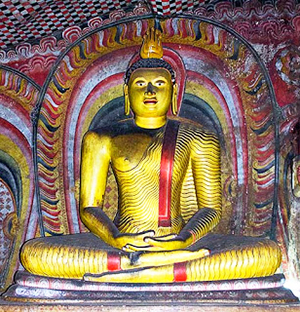Dambulla Cave Temple History, Facts, Tourist Attractions

Photo: Buddha statue at Dambulla temple
The Dambulla Cave Temple is located 24 km (30 min) from Sigiriya in central Sri Lanka. Originally built in about 80BC It is the largest and best preserved cave temple in Sri Lanka. Inside are 153 Buddha statues in various reposes, three statues of ancient kings, and four other statues including those of Vishnu and Ganesh. The eyes on some of the statues are interesting. The ceiling and walls have been repainted over the centuries contain a juxtapose of imagery including those of royal life.
The site of this temple has been inhabited since prehistoric times and inhabited by aesthetic monks who dwelled in the caves there. The first recorded history of the dambulla caves goes back over two thousand years to the time of King Valagama (ruled 103 BC and again 89 BC – 77 BC). The king sort refuge amongst the monks living in these caves when he was ousted from power in 103 BC by South Indian marauders who invaded the country. After a grueling 14 year campaign Valagama finally regained control of his kingdom and in thanksgiving built the original vihara (monastery) on this site. Since then the site has evolved organically into its present state.
The beauty of this cave temple is its setting, being built into five huge caverns high on a mountainside. The modern additions at the base of the hill a bit garish and lack finesse.
Entry Fees, Opening Hours and Visit Duration
Entry Fee: $14 per person (ticket counter located on left at the main building)
Opening Hours: 7:30AM -7:00PM
Visit: 2-3 hours
Dambulla Weather Weather Conditions for Climbing
Dambulla, has a hot and humid tropical climate. The weather in general is unpredictable. Torrential downpours occur frequently. These are usually short-lived and tend to be in the afternoons. More detail can be found on our Climate and Weather page.
Climbing to the Dambulla Cave Temples Strenuous Climbing Involved
Since the ancient site is located on a mountainside there is a rather strenuous climb to the top. The climb to the temple is rather strenuous.
The lower levels of of the temple with its mo0dern temple compound are relatively easy to get to on flat surfaces with few steps. Climbing to the cave temples on the top of the rock is difficult and very strenuous. It should only be attempted by those who are fit.
Safety factors to consider include the difficult and dangerous climb to the top and dehydration. Use common-sense and you will be assured an incident-free visit. Visit our Sigiriya Safety and Comfort page for more information.
Dress Code What to Wear
This is a fully functioning temple. So be respective of the worshipers there. Dress appropriately.
As with all religious establishments in Sri Lanka, dress modestly. Wear clothes that cover your shoulders and thighs (knee length).A sarong can come in very handy for this purpose. Don't wear hats or caps inside the buildings. Remove your footwear before entering the temple precinct. Loose cotton, linen or breathable fabrics are best.
A broad brimmed hat, sunscreen and sunglasses are a good idea to protect yourself while climbing to the cave temples. Any footwear suitable for the tropics is fine.
Photography No Flash Photography & Posing
Photography (no flash) is permitted but don't offend local sensibility by posing with the statues especially with your back turned to them. To do so is considered extremely rude and disrespectful.

